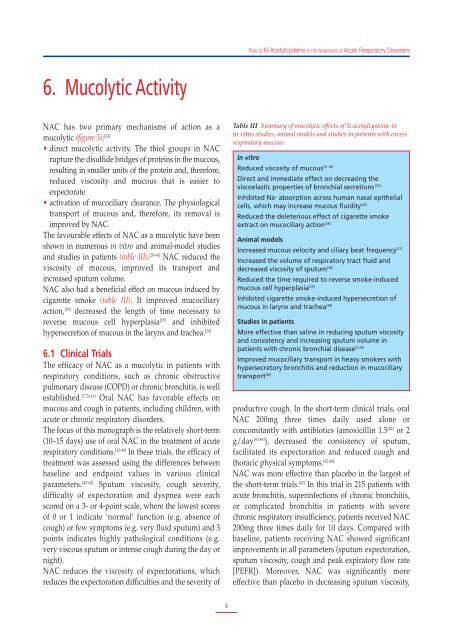Therapeutics
Role of N-Acetylcysteine
Role of N-Acetylcysteine
- No tags were found...
You also want an ePaper? Increase the reach of your titles
YUMPU automatically turns print PDFs into web optimized ePapers that Google loves.
Role of N-Acetylcysteine in the treatment of Acute Respiratory Disorders<br />
6. Mucolytic Activity<br />
NAC has two primary mechanisms of action as a<br />
mucolytic (figure 5): [24]<br />
• direct mucolytic activity. The thiol groups in NAC<br />
rupture the disulfide bridges of proteins in the mucous,<br />
resulting in smaller units of the protein and, therefore,<br />
reduced viscosity and mucous that is easier to<br />
expectorate<br />
• activation of mucociliary clearance. The physiological<br />
transport of mucous and, therefore, its removal is<br />
improved by NAC.<br />
The favourable effects of NAC as a mucolytic have been<br />
shown in numerous in vitro and animal-model studies<br />
and studies in patients (table III). [28-40] NAC reduced the<br />
viscosity of mucous, improved its transport and<br />
increased sputum volume.<br />
NAC also had a beneficial effect on mucous induced by<br />
cigarette smoke (table III). It improved mucociliary<br />
action, [28] decreased the length of time necessary to<br />
reverse mucous cell hyperplasia [29] and inhibited<br />
hypersecretion of mucous in the larynx and trachea. [30]<br />
6.1 Clinical Trials<br />
The efficacy of NAC as a mucolytic in patients with<br />
respiratory conditions, such as chronic obstructive<br />
pulmonary disease (COPD) or chronic bronchitis, is well<br />
established. [7,24,41] Oral NAC has favorable effects on<br />
mucous and cough in patients, including children, with<br />
acute or chronic respiratory disorders.<br />
The focus of this monograph is the relatively short-term<br />
(10–15 days) use of oral NAC in the treatment of acute<br />
respiratory conditions. [42-44] In these trials, the efficacy of<br />
treatment was assessed using the differences between<br />
baseline and endpoint values in various clinical<br />
parameters. [42-44] Sputum viscosity, cough severity,<br />
difficulty of expectoration and dyspnea were each<br />
scored on a 3- or 4-point scale, where the lowest scores<br />
of 0 or 1 indicate ‘normal‘ function (e.g. absence of<br />
cough) or few symptoms (e.g. very fluid sputum) and 3<br />
points indicates highly pathological conditions (e.g.<br />
very viscous sputum or intense cough during the day or<br />
night).<br />
NAC reduces the viscosity of expectorations, which<br />
reduces the expectoration difficulties and the severity of<br />
Table III Summary of mucolytic effects of N-acetylcysteine in<br />
in vitro studies, animal models and studies in patients with excess<br />
respiratory mucous<br />
In vitro<br />
Reduced viscosity of mucous [31-34]<br />
Direct and immediate effect on decreasing the<br />
viscoelastic properties of bronchial secretions [35]<br />
Inhibited Na + absorption across human nasal epithelial<br />
cells, which may increase mucous fluidity [36]<br />
Reduced the deleterious effect of cigarette smoke<br />
extract on mucociliary action [28]<br />
Animal models<br />
Increased mucous velocity and ciliary beat frequency [37]<br />
Increased the volume of respiratory tract fluid and<br />
decreased viscosity of sputum [38]<br />
Reduced the time required to reverse smoke-induced<br />
mucous cell hyperplasia [29]<br />
Inhibited cigarette smoke-induced hypersecretion of<br />
mucous in larynx and trachea [30]<br />
Studies in patients<br />
More effective than saline in reducing sputum viscosity<br />
and consistency and increasing sputum volume in<br />
patients with chronic bronchial disease [2,39]<br />
Improved mucociliary transport in heavy smokers with<br />
hypersecretory bronchitis and reduction in mucociliary<br />
transport [40]<br />
productive cough. In the short-term clinical trials, oral<br />
NAC 200mg three times daily used alone or<br />
concomitantly with antibiotics (amoxicillin 1.5 [42] or 2<br />
g/day [43,44] ), decreased the consistency of sputum,<br />
facilitated its expectoration and reduced cough and<br />
thoracic physical symptoms. [42-44]<br />
NAC was more effective than placebo in the largest of<br />
the short-term trials. [42] In this trial in 215 patients with<br />
acute bronchitis, superinfections of chronic bronchitis,<br />
or complicated bronchitis in patients with severe<br />
chronic respiratory insufficiency, patients received NAC<br />
200mg three times daily for 10 days. Compared with<br />
baseline, patients receiving NAC showed significant<br />
improvements in all parameters (sputum expectoration,<br />
sputum viscosity, cough and peak expiratory flow rate<br />
[PEFR]). Moreover, NAC was significantly more<br />
effective than placebo in decreasing sputum viscosity,<br />
9


